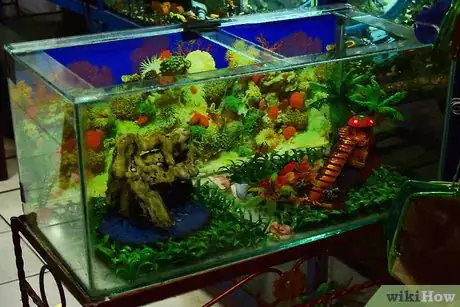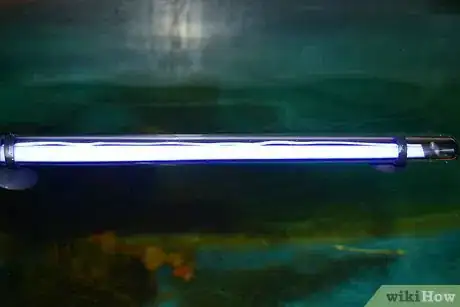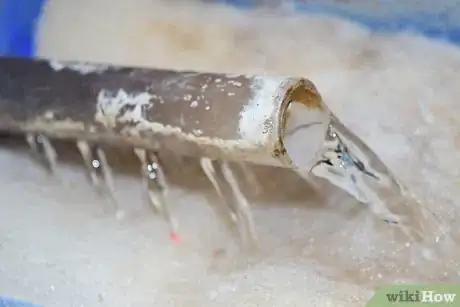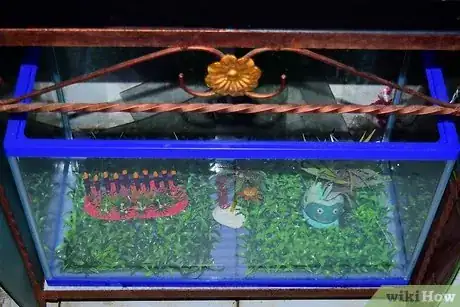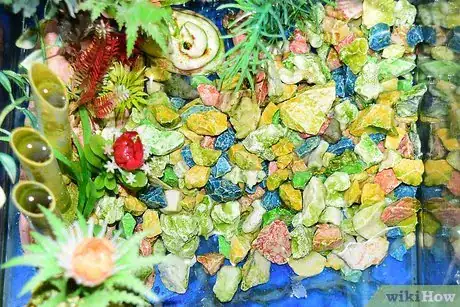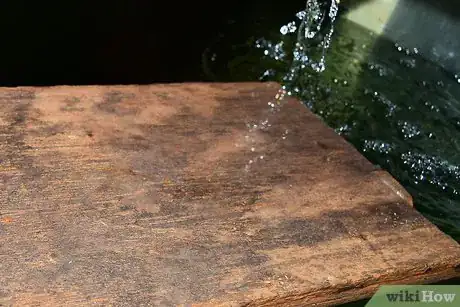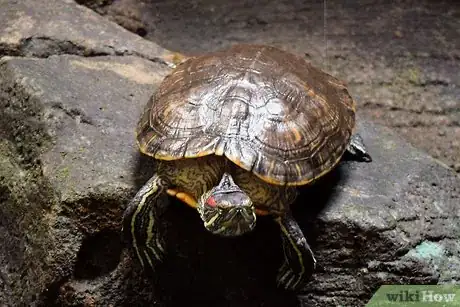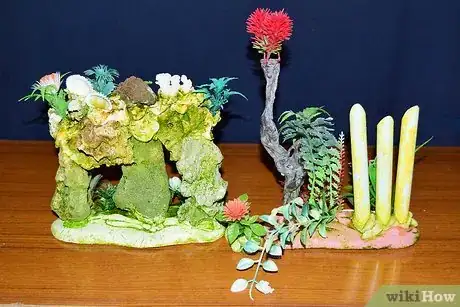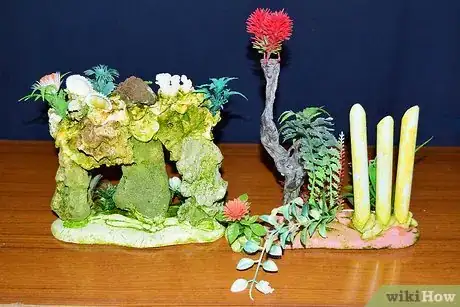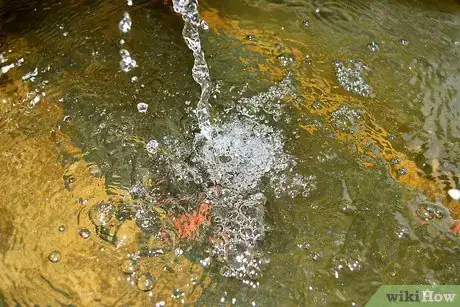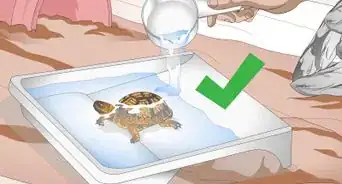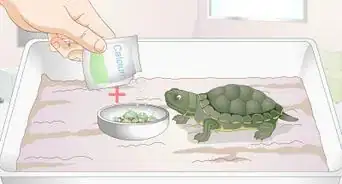This article was co-authored by Audra Barrios. Audra Barrios is a Marine Biologist and owner of Lick Your Eyeballs, a business offering experiemces, reptiles, supplies and plants. With over 15 years of experience, Audra specializes in reptiles and exotic animals, environmental education, marine biology, conservation issues, and animal husbandry. Audra earned a BASc in Marine Biology from the University of California, Santa Cruz, and studied Natural Sciences at the College of Marin. She is the founder and Executive Director of Things That Creep, a non-profit dedicated to herptile conservation through education. She has spent the last nine years working as a biologist at the California Academy of Sciences.
wikiHow marks an article as reader-approved once it receives enough positive feedback. In this case, 90% of readers who voted found the article helpful, earning it our reader-approved status.
This article has been viewed 291,341 times.
Caring for a turtle can be a very rewarding and relaxing experience, but you also need to take the responsibility seriously by setting up an appropriate tank for your new aquatic or semi-aquatic friend. A good turtle tank will have both water and land areas, and the conditions of the tank will be maintained by proper lighting and filtering.
Steps
The Basic Structure
-
1Choose a large, sturdy glass tank. Your turtle will need a glass fish tank that can provide roughly 10 to 15 gallons (38 to 57 L) of water for every 1 inch (2.5 cm) of turtle.
- If you do not have a mature turtle, base your measurements off the average size your turtle's species reaches upon maturity.
- Do not use a reptile tank designed for terrestrial (land-living) reptiles. The glass is too thin and can break due to the pressure of the water. The glass used for turtle tanks should be at least 0.4 inches (10 mm) thick.
- If you have more than one turtle, size the tank according to your first turtle and add half that size to your original measurement for each additional turtle. This should give you your final tank size.
- Keep in mind that the tank should be deeper than it is wide. Otherwise, your turtle may not have enough room to flip itself upright if it accidentally turns upside-down.
- For most turtles, the length of the tank should be three or four times the length of the turtle and the width should be twice the length of the turtle. The height of the tank should be one and a half to two times the length of the turtle, but you should also make sure that there is a full 1 foot (30.5 cm) above the highest point the turtle can reach when placed inside the tank to prevent the turtle from climbing out.
-
2Provide a lamp. You can use a lamp that hooks onto the turtle tank, or you could opt for one that stands separately but can be directed down onto the tank.
- The light itself needs to shine on the portion of the tank you intend to set aside as a basking area.
- Turtles need a high-quality UV light to stay healthy.[1] Get a light with both UVA and UVB bulbs. UVB light stimulates the production of vitamin D3 and maintains the natural environment, while UVA light encourages more activity and a heartier appetite. UVB bulbs should provide the main lighting. UVB light will help it develop its shell.
- You should also consider running the light on a timer to simulate natural light cycles. Most turtles need a natural light cycle of 12 to 14 hours, followed by 10 to 12 hours of darkness.
- On a related note, you'll also need to keep the tank in a good location. You can place the tank near indirect sunlight or in shade, but do not place it in direct sunlight. Bright, full sun could end up baking and killing the turtle.
Advertisement -
3Consider using a water heater. Use a fully submersible water heater to help maintain a consistent temperature year-round. These heaters attach to the side of the aquarium with suction cups.
- You may need to hide the heater behind a wall to prevent the turtle from breaking it as it swims around.
- Before installing a water heater, make sure that your turtle needs one. The preferred temperature will depend on the turtle species. A species that prefers room temperature water usually doesn't need a water heater, but those that prefer warmer temperatures might.
-
4Invest in a good filter. Filters are vital to the health of your tank.[2] Turtles produce more waste than fish, though, and without a filter, you would need to change the water daily.
- Large canister filters work best.[3] They can be expensive, but the size ensures that filter will not get clogged up easily. As a result, the tank will stay more sanitary and the turtle will remain healthier. A canister filter also minimizes the amount of cleaning you have to do. Lastly, even though the initial cost of a canister filter is higher than it is with other filter types, the long-term costs associated with water and filter changes will actually be lower.
- If you use an internal filter instead of a canister filter, use the largest you can find and opt for two filters instead of one.
- Even with a good filter, you will need to change the water at least once every two weeks.
-
5Look at tank covers. Select a heat-proof metal screen cover for the top of your tank. While not strictly essential, covers will protect your turtle from potential threats like broken lamp bulbs.[4]
- Since lamp bulbs used for turtle habitats tend to get very hot, they can easily explode if they get splashed with water, making this a very real threat.
- You may also want to clamp the cover onto the top of your tank to prevent larger turtles from climbing out.
- Do not use glass or plexiglass tank covers since these materials filter out the UVB rays a turtle needs for survival. Moreover, these materials are more likely to shatter or melt.
-
6Get the tools you'll need to monitor conditions. Conditions can change slightly over time when left alone, so you will need to monitor and maintain the right conditions regularly to keep your turtle healthy.
- Use thermometers to monitor the temperature of the water and the temperature of the basking/land area. Most turtles prefer water temperatures around 78 degrees Fahrenheit (25 degrees Celsius). Land temperatures should be between 80 and 85 degrees Fahrenheit (27 and 29 degrees Celsius).[5]
- You should also keep an eye on the humidity in your tank, so you'll need a hygrometer to do this. The right humidity level will depend on the turtle species, and you can change humidity inside the tank by adding or removing substrate from the land/basking area.
The Habitat
-
1Spread substrate on the bottom of the tank only if needed. Generally, you don't need to cover the bottom of the tank with any substrate.[6] The only time this is a necessity is if you decide to place live plants in the tank.
- Substrate can actually make the tank more difficult to clean.
- If you're going to use substrate, the best choices are fine sand, gravel, and fluorite.
- Sand is difficult to clean, but some turtles do enjoy digging in it.
- Gravel can create a nice appearance, but you need to make sure that the gravel pieces are more than 1/2 inch (1.5 cm) in diameter; otherwise, the turtle may try eating the gravel.
- Fluorite is a porous clay gravel that provides plenty of nutrients for plants. Turtles generally don't eat it, but you should still opt for larger fluorite just to be safe.
-
2Create a land area. Aquatic and semi-aquatic turtles both need a land area inside the tank.[7] Most semi-aquatic turtles need a land area that takes up at least 50 percent of the space in the tank. Most aquatic turtles should have a land mass that takes up no more than 25 percent of the space in the tank.
- Turtles use this land area to bask and dry themselves.[8]
- The diameter of the land mass should also be at least one and a half times as long as the length of the turtle.
- There are plenty of different options to consider. You can buy a special turtle dock from a pet supply store, or you could use a rock or log. Floating docks are often preferable since they adjust to the water level and do not take up valuable room inside the tank.
- Avoid using rocks and logs from nature since they can pose a health threat to your turtle. If you do use something from nature, boil it in a separate pot of water to kill any algae, germs, or dangerous microorganisms.
- If you want to use something for a land mass that does not have a weight to anchor it, glue the land in place along the side of the tank with silicone aquarium sealant.
-
3Provide a water-to-land ramp, if necessary. Turtles need a way to climb onto the land area. Ideally, the land area itself should gently slope down into the water. If it doesn't, you will need to install a separate ramp.
- The ramp itself can be fairly simple. For instance, a curves or sloping log can be attached to the land area from one side, with the other side dipping down gently into the water. A piece of thick plastic can also be used in a similar way.
-
4Choose the right decorations. Turtles do not need many decorations to survive, but adding a few can make the tank nicer to look at and may also help your turtle feel a little more secure.
- Add logs, smooth rocks, and terrestrial (land) plants to provide hiding places on the basking area. You could also use a wooden enclosure. Just make sure that the turtle still has plenty of room to spread out on the empty portion of the basking area.
- Real plants work great, but note that turtles will nibble on them, so you should only choose aquatic and terrestrial plants that are non-toxic to turtles.
- Decorations with sharp edges pose a threat to your turtle and should be avoided.
- Store bought decorations do not need to be sterilized, but decorations picked up from nature need to be boiled separately to kill off harmful germs.
- Never use a decoration with a diameter less than 1 inch (2.5 cm) since the turtle may try to eat it.
- Avoid enclosure-style decorations since your turtle may get stuck while swimming under it.
-
5Place decorations and equipment carefully. All foreign objects in the tank should be placed along the edges so that the turtle can swim freely. You can also place equipment beneath the land area to hide it.
- If you want to place something in the center of the tank, opt for clumps of plants since these will not interfere with the turtle's ability to swim. Place tall or stiff decorations only in the edges.
- Make sure that you do not create any enclosures or tight spots that your turtle could get stuck in as you place equipment and decorations in the tank.
-
6Fill the tank with clean water. Fill the tank with enough water for the turtle to swim comfortably. Most turtles need at least 4 to 6 inches (10 to 15.25 cm) of water.
- You need to make sure that the water depth is at least three-quarters the length of the turtle. This depth allows the turtle to flip itself upright if it accidentally turns upside-down in the water.
- The vast majority of pet turtles are freshwater creatures, so you should provide clean water from your sink or from jugs of distilled water.
Community Q&A
-
QuestionCan a small research slider flip over?
 Community AnswerIt depends on how much water you have in the tank, but usually not as they are very well balanced.
Community AnswerIt depends on how much water you have in the tank, but usually not as they are very well balanced. -
QuestionThe water in the tank seems to be constantly cloudy. I keep cleaning it but it does not change. Any suggestions?
 Community AnswerDo you have a filter and are you cleaning the filter? Sometimes that releases particulates into the water, making it cloudy. Rinse the filters really well before putting back in the tank. There is a chemical you can buy that is a water clarifier; this works quickly, in an hour or two. Also - do you have hard water? That might be an issue.
Community AnswerDo you have a filter and are you cleaning the filter? Sometimes that releases particulates into the water, making it cloudy. Rinse the filters really well before putting back in the tank. There is a chemical you can buy that is a water clarifier; this works quickly, in an hour or two. Also - do you have hard water? That might be an issue. -
QuestionWhat fish are suitable with turtles?
 Community AnswerYou'll need to find fish which are large enough to not be considered food by the turtle, but gentle enough that they don't bully the turtle. Larger goldfish or koi fit into this category well.
Community AnswerYou'll need to find fish which are large enough to not be considered food by the turtle, but gentle enough that they don't bully the turtle. Larger goldfish or koi fit into this category well.
Things You'll Need
- Large glass fish tank
- Water
- Land area (rock, log, floating shelf, etc.)
- Lamp
- Fluorescent bulb with UVA and UVB rays
- Submersible water heater
- Thermometer
- Hygrometer
- Canister filter, or other water filter
- Heat-proof metal screen cover
- Substrate (optional)
- Tank decorations (optional)
References
- ↑ Audra Barrios. Marine Biologist & Reptile Specialist. Expert Interview. 18 August 2020.
- ↑ Audra Barrios. Marine Biologist & Reptile Specialist. Expert Interview. 18 August 2020.
- ↑ http://www.turtlepuddle.org/health/small_tank_filter.html
- ↑ https://www.buildyouraquarium.com/turtle-tank-setup/
- ↑ http://www.drsfostersmith.com/pic/article.cfm?aid=2230
- ↑ http://www.reptilesmagazine.com/Turtles-Tortoises/Turtle-Care/Keeping-a-Turtle-Here-are-Some-Tips-All-New-Turtlekeepers-Need-To-Know/
- ↑ https://www.theaquariumguide.com/turtle-tank-set-up-and-maintenance
- ↑ Audra Barrios. Marine Biologist & Reptile Specialist. Expert Interview. 18 August 2020.
About This Article
To set up a turtle tank, choose a sturdy glass 10-15 gallon tank, and set it up with filter and a lamp that provides UVA and UVB light to mimic the natural environment. You should also obtain a thermometer and a hygrometer to make sure you maintain the proper temperature and humidity for your turtle’s species. Create a dry area that covers 50% of the tank for semi-aquatic turtles or 25% of the tank for aquatic turtles, and make sure there is a ramp so the turtle can easily climb from the water to the dry area. For tips on decorating the tank, read on!
